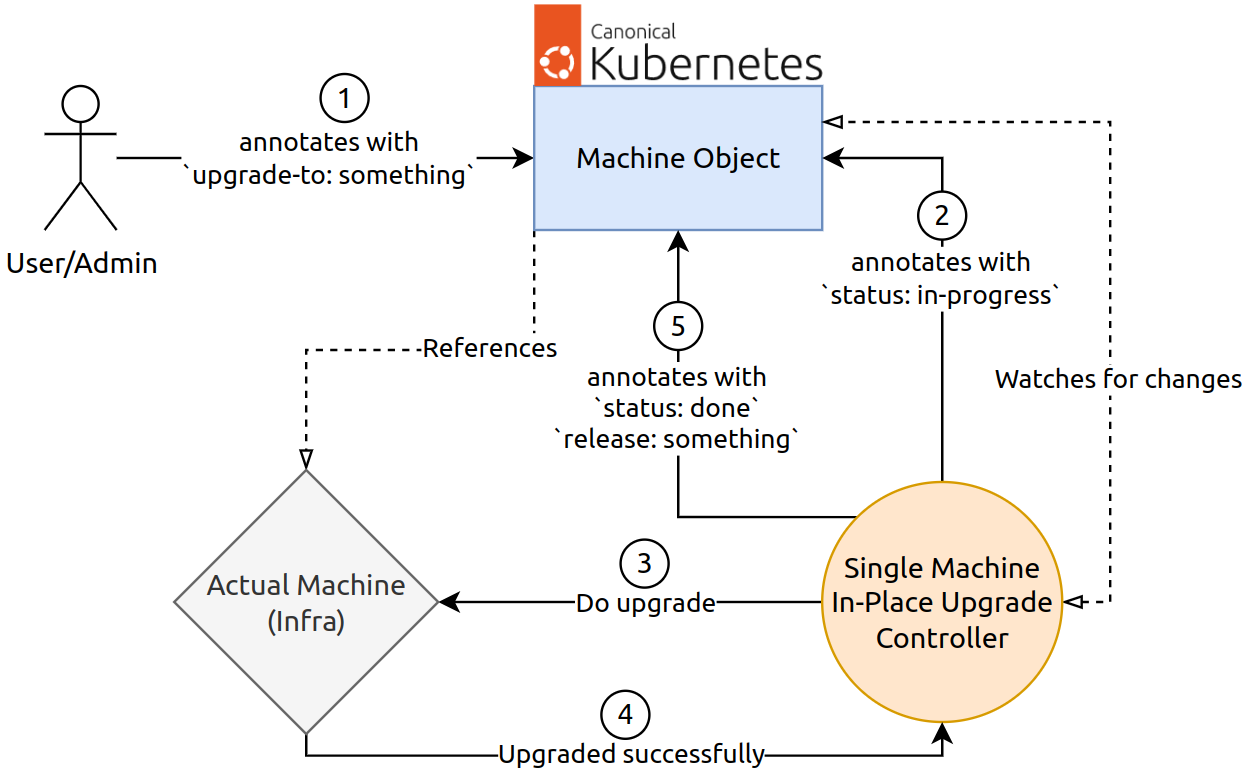In-place upgrades¶
Regularly upgrading the Kubernetes version of the machines in a cluster is important. While rolling upgrades are a popular strategy, certain situations will require in-place upgrades:
Resource constraints (i.e. cost of additional machines).
Expensive manual setup process for nodes.
Annotations¶
CAPI machines are considered immutable. Consequently, machines are replaced
instead of reconfigured.
While CAPI doesn’t support in-place upgrades, Canonical Kubernetes CAPI does
by leveraging annotations for the implementation.
For a deeper understanding of the CAPI design decisions, consider reading about
machine immutability in CAPI, and Kubernetes objects: labels,
spec and status.
Controllers¶
In Canonical Kubernetes CAPI, there are two main types of controllers that handle the process of performing in-place upgrades:
Single Machine In-Place Upgrade Controller
Orchestrated In-Place Upgrade Controller
The core component of performing an in-place upgrade is the Single Machine Upgrader. The controller watches for annotations on machines and reconciles
them to ensure the upgrades happen smoothly.
The Orchestrator watches for certain annotations on
machine owners, reconciles them and upgrades groups of owned machines.
It’s responsible for ensuring that all the machines owned by the
reconciled object get upgraded successfully.
The main annotations that drive the upgrade process are as follows:
v1beta2.k8sd.io/in-place-upgrade-to–>upgrade-to: Instructs the controller to perform an upgrade with the specified option/method.v1beta2.k8sd.io/in-place-upgrade-status–>status: As soon as the controller starts the upgrade process, the object will be marked with thestatusannotation which can either bein-progress,failedordone.v1beta2.k8sd.io/in-place-upgrade-release–>release: When the upgrade is performed successfully, this annotation will indicate the current Kubernetes release/version installed on the machine.
For a complete list of annotations and their values please refer to the annotations reference page. This explanation proceeds to use abbreviations of the mentioned labels.
Single machine in-place upgrade controller¶
The Machine objects can be marked with the upgrade-to annotation to
trigger an in-place upgrade for that machine. While watching for changes
on the machines, the single machine upgrade controller notices this annotation
and attempts to upgrade the Kubernetes version of that machine to the
specified version.
Upgrade methods or options can be specified to upgrade to a snap channel, revision, or a local snap file already placed on the machine in air-gapped environments.
A successfully upgraded machine shows the following annotations:
annotations:
v1beta2.k8sd.io/in-place-upgrade-release: "channel=1.31/stable"
v1beta2.k8sd.io/in-place-upgrade-status: "done"
If the upgrade fails, the controller will mark the machine and retry the upgrade immediately:
annotations:
# the `upgrade-to` causes the retry to happen
v1beta2.k8sd.io/in-place-upgrade-to: "channel=1.31/stable"
v1beta2.k8sd.io/in-place-upgrade-status: "failed"
# orchestrator will notice this annotation and knows that the
# upgrade for this machine failed
v1beta2.k8sd.io/in-place-upgrade-last-failed-attempt-at: "Sat, 7 Nov
2024 13:30:00 +0400"
By applying and removing annotations, the single machine upgrader determines the upgrade status of the machine it’s trying to reconcile and takes necessary actions to successfully complete an in-place upgrade. The following diagram shows the flow of the in-place upgrade of a single machine:

Machine Upgrade Process¶
The Canonical Kubernetes’s k8sd daemon exposes endpoints that can be used to
interact with the cluster. The single machine upgrader calls the
/snap/refresh endpoint on the machine to trigger the upgrade
process while checking /snap/refresh-status periodically.

In-place upgrades on large workload clusters¶
While the “Single Machine In-Place Upgrade Controller” is responsible
for upgrading individual machines, the “Orchestrated In-Place Upgrade
Controller” ensures that groups of machines will get upgraded.
By applying the upgrade-to annotation on an object that owns machines
(e.g. a MachineDeployment), this controller will mark the owned machines
one by one which will cause the “Single Machine Upgrader” to pickup those
annotations and upgrade the machines. To avoid undesirable situations
like quorum loss or severe downtime, these upgrades happen in sequence.
The failures and successes of individual machine upgrades will be reported back to the orchestrator by the single machine upgrader via annotations.
The illustrated flow of orchestrated in-place upgrades:

